Overview
George Oberteuffer was born on October 31st, 1878 in Philadelphia, Pennsylvania. He attended Princeton University and graduated in 1900. After graduation Oberteuffer enrolled in the Pennsylvania Academy of Fine Arts along with fellow artists Thomas Anschutz and William Merritt Chase. In 1901 the artist traveled to France where he remained until 1920 to study, paint, and teach art. In 1905 while attending the Académie Julian in Paris, Oberteuffer met his future wife Henriette Amiard. The two often exhibited their works together, and it seemed as though their relationship contributed to the success of their mutual careers. While in Paris, Oberteuffer became a member of the Sociétaire du Salon d'Automne as well as the Salon des Indépendents. He also is known to have taught at the Académie de la Grande Chaumière from 1919 until 1920. Oberteuffer and his wife returned to the United States in 1922, and he began a brief tenure as an instructor at the Pennsylvania Academy of Fine Arts. He then went on to teach at the Minneapolis Museum School of Art, the School of the Art Institute of Chicago as well as the Grand Central School of Art in New York. In 1939 Oberteuffer became a member of the National Academy of Design. In 1940 while George and Henriette Oberteuffer were living in Boston, The Vose Gallery held an Oberteuffer family exhibition that included the work of their son Karl. This exhibition would be the last one for George Oberteuffer. Sadly a short time afterwards while working on a large mural commission for the W.P.A. along with his wife, George Oberteuffer contracted pneumonia and died.
Memberships
Chicago Galleries Association
Chicago Painters and Sculptors
National Academy of Design, Associate 1937; Member, 1938
National Art Club
Salon d'Automne
Salon des Indépendents
Exhibitions
Corcoran Gallery Biennials, 1912-27 (6 times)
Art Institute of Chicago, 1912-31; Logan Medal, 1926
Knoedler Galleries, Paris and New York, 1920 (solo)
Feragil Gallery, New York, 1921 (solo)
Wisconsin Painters and Sculptors, 1922 (gold)
Pennsylvania Academy of Fine Arts, 1923 (Sesnen Gold Medal)
Milwaukee Medal of Honor, circa 1925
Chicago Galleries Association, 1927 (prize)
National Academy of Design 107th Annual, 1932 (Second Altman Prize)
R.C. Vose Gallery, Boston, 1940 (solo)
Carnegie International, Pittsburgh, Pennsylvania
Corcoran Gallery of Art, Washington, D.C.
International Society of London
Philadelphia Art Alliance, Pennsylvania
Royal Scottish Academy, London
Salons of America
Graham Gallery, New York, 1965
Museums and Public Collections
Art Gallery of New South Wales, Sydney, Australia
Art Institute of Chicago, Illinois
Brooklyn Museum of Art
Columbus Art Museum, Ohio
French National Collection
Gallery of Fine Art, Columbus, Ohio
Grand Rapids Museum, Michigan
Luxembourg Museum, Paris
Milwaukee Art Institute, Wisconsin
National Gallery of Art, Washington, D.C.
Phillips Collections, Washington, D.C.

